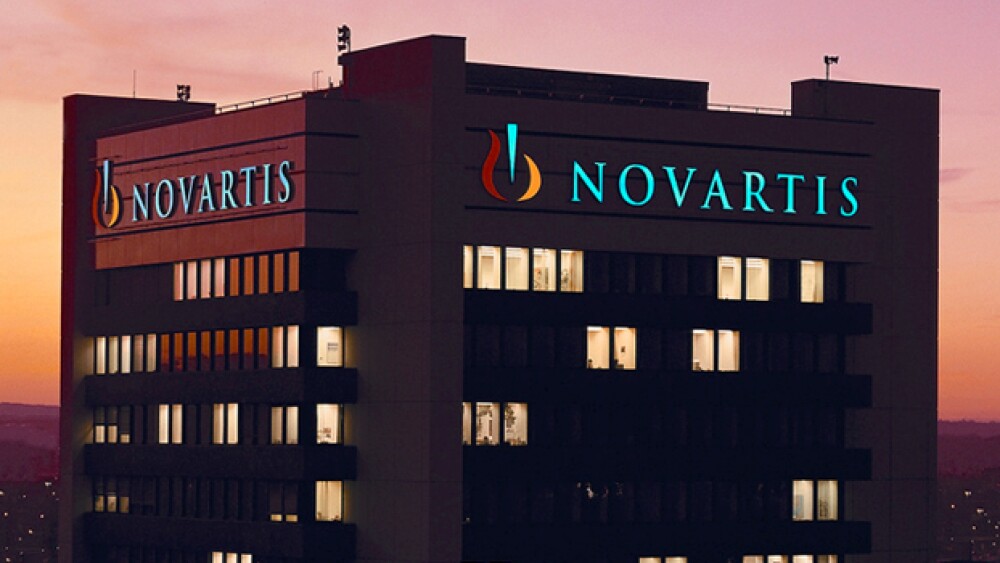Spark won approval on Dec. 2017 as a one-time gene therapy to restore functional vision in children and adult patients with biallelic mutations of the RPE65.
Novartis Exclusively Licenses First Ophthalmology Gene Therapy in All Markets Outside the US, A Milestone for Patients With Rare Inherited Vision Loss
- Novartis enters into a licensing and supply agreement to develop, register and commercialize investigational gene therapy voretigene neparvovec outside the US; Spark Therapeutics retains US rights for LUXTURNA(TM) (voretigene neparvovec-rzyl)
- Voretigene neparvovec is an investigational one-time gene therapy to restore functional vision for patients with biallelic mutations of the RPE65 gene
- This investigational therapy provides patients with a working copy of the RPE65 gene to treat otherwise progressive vision loss that typically leads to blindness
Basel, January 24, 2018 - Novartis today announced a licensing agreement with Spark Therapeutics covering development, registration and commercialization rights to voretigene neparvovec in markets outside the US. Voretigene neparvovec, known as LUXTURNA(TM) (voretigene neparvovec-rzyl) in the US, received FDA approval on December 19, 2017 as a one-time gene therapy to restore functional vision in children and adult patients with biallelic mutations of the RPE65 (retinal pigment epithelial 65 kDa protein) gene[1]. The market authorization application (MAA) with the European Medicines Agency (EMA) was filed on July 31, 2017. Currently there is no existing therapy for this disease outside the US.
"No otherwise healthy child should have to go blind due to this devastating disease. Gene therapy is a promising new avenue to potentially address this unmet need," said Shreeram Aradhye, Global Head of Medical Affairs and Chief Medical Officer, Novartis Pharmaceuticals. "This collaboration builds on our commitment to ophthalmology. We look forward to leveraging our global presence to ensure that patients outside the US have access to this potentially life-changing treatment."
Novartis will make an upfront payment as well as pay milestones and royalties to Spark Therapeutics reflective of the late stage of the opportunity. Spark Therapeutics retains exclusive rights for LUXTURNA(TM) in the US and will retain responsibility for obtaining EMA approval. Commercialization rights will be transferred to Novartis upon successful completion of registration and issuance of market authorization. Novartis has exclusive rights to pursue development, registration and commercialization in all other countries outside the US. Spark Therapeutics will be responsible for the supply of voretigene neparvovec worldwide under a separate manufacturing and supply agreement with Novartis.
Mutations in the RPE65 gene lead to reduced or absent levels of RPE65 isomerohydrolase activity, blocking the visual cycle and resulting in progressive vision loss and ultimately, blindness[1]. Only a few thousand people worldwide are affected by this ultra-orphan condition[1], [2]. Pending approval, Novartis will work with physicians to establish new approaches to facilitating diagnosis and treatment at specialized treatment centers.
About Novartis in ophthalmology
Novartis is a leading ophthalmology company, with therapies that treat both front and back of the eye disorders, including retina diseases, glaucoma, dry eye and other external eye diseases. In 2016, approximately 200 million patients worldwide were treated with Novartis ophthalmic products.
About LUXTURNA(TM)
LUXTURNA(TM) is an adeno-associated virus (AAV) vector-based gene therapy indicated in the United States for the treatment of patients with confirmed biallelic RPE65 mutation-associated retinal dystrophy. Patients must have viable retinal cells as determined by the treating physician. Mutations in the RPE65 (retinal pigment epithelial 65 kDa protein) gene lead to reduced or absent levels of RPE65 isomerohydrolase activity, blocking the visual cycle and resulting in impairment of vision. Injection of LUXTURNA(TM) into the subretinal space results in transduction of some retinal pigment epithelial cells with a cDNA encoding normal human RPE65 protein, thus providing the potential to restore the visual cycle.
The safety data reflect exposure to LUXTURNA(TM) in two clinical trials consisting of 41 subjects (81 eyes) with confirmed biallelic RPE65 mutation-associated retinal dystrophy. 40 of the 41 subjects received sequential subretinal injections to each eye. The efficacy in pediatric and adult patients with biallelic RPE65 mutation-associated retinal dystrophy was evaluated in an open-label, two-center, randomized trial. The average age of the 31 randomized subjects was 15 years (range 4 to 44 years), including 64% pediatric subjects (n=20, age from 4 to 17 years) and 36% adults (n=11). The efficacy of LUXTURNA was established on the basis of multi-luminance mobility testing (MLMT) score change from Baseline to Year 1.
Indication and Important Safety Information
LUXTURNA (voretigene neparvovec-rzyl) is an adeno-associated virus vector-based gene therapy indicated for the treatment of patients with confirmed biallelic RPE65 mutation-associated retinal dystrophy.
Patients must have viable retinal cells as determined by the treating physicians.
Warnings and Precautions
- Endophthalmitis may occur following any intraocular surgical procedure or injection. Use proper aseptic injection technique when administering LUXTURNA, and monitor for and advise patients to report any signs or symptoms of infection or inflammation to permit early treatment of any infection.
- Permanent decline in visual acuity may occur following subretinal injection of LUXTURNA. Monitor patients for visual disturbances.
- Retinal abnormalities may occur during or following the subretinal injection of LUXTURNA, including macular holes, foveal thinning, loss of foveal function, foveal dehiscence, and retinal hemorrhage. Monitor and manage these retinal abnormalities appropriately. Do not administer LUXTURNA in the immediate vicinity of the fovea. Retinal abnormalities may occur during or following vitrectomy, including retinal tears, epiretinal membrane, or retinal detachment. Monitor patients during and following the injection to permit early treatment of these retinal abnormalities. Advise patients to report any signs or symptoms of retinal tears and/or detachment without delay.
- Increased intraocular pressure may occur after subretinal injection of LUXTURNA. Monitor and manage intraocular pressure appropriately.
- Expansion of intraocular air bubbles Instruct patients to avoid air travel, travel to high elevations or scuba diving until the air bubble formed following administration of LUXTURNA has completely dissipated from the eye. It may take one week or more following injection for the air bubble to dissipate. A change in altitude while the air bubble is still present can result in irreversible vision loss. Verify the dissipation of the air bubble through ophthalmic examination.
- Cataract Subretinal injection of LUXTURNA, especially vitrectomy surgery, is associated with an increased incidence of cataract development and/or progression.
Adverse Reactions
- In clinical studies, ocular adverse reactions occurred in 66% of study participants (57% of injected eyes), and may have been related to LUXTURNA, the subretinal injection procedure, the concomitant use of corticosteroids, or a combination of these procedures and products.
- The most common adverse reactions (incidence >= 5% of study participants) were conjunctival hyperemia (22%), cataract (20%), increased intraocular pressure (15%), retinal tear (10%), dellen (thinning of the corneal stroma) (7%), macular hole (7%), subretinal deposits (7%), eye inflammation (5%), eye irritation (5%), eye pain (5%), and maculopathy (wrinkling on the surface of the macula) (5%).
Immunogenicity
Immune reactions and extra-ocular exposure to LUXTURNA in clinical studies were mild. No clinically significant cytotoxic T-cell response to either AAV2 or RPE65 has been observed. Study participants received systemic corticosteroids before and after subretinal injection of LUXTURNA to each eye, which may have decreased the potential immune reaction to either AAV2 or RPE65.
Pediatric Use
Treatment with LUXTURNA is not recommended for patients younger than 12 months of age, because the retinal cells are still undergoing cell proliferation, and LUXTURNA would potentially be diluted or lost during the cell proliferation. The safety and efficacy of LUXTURNA have been established in pediatric patients. There were no significant differences in safety between the different age subgroups.
Please see the full US Prescribing Information for LUXTURNA here.
Disclaimer
This press release contains forward-looking statements within the meaning of the United States Private Securities Litigation Reform Act of 1995. Forward-looking statements can generally be identified by words such as "promising," "potentially," "builds on," "commitment," "potential," "will," "look forward," "investigational," "currently," or similar terms, or by express or implied discussions regarding potential marketing approvals, new indications or labeling for voretigene neparvovec and the other investigational and approved products described in this press release, or regarding potential future revenues from such products, or regarding the licensing agreement and the manufacturing and supply agreement with Spark Therapeutics. You should not place undue reliance on these statements. Such forward-looking statements are based on our current beliefs and expectations regarding future events, and are subject to significant known and unknown risks and uncertainties. Should one or more of these risks or uncertainties materialize, or should underlying assumptions prove incorrect, actual results may vary materially from those set forth in the forward-looking statements. There can be no guarantee that voretigene neparvovec or the other investigational or approved products described in this press release will be submitted or approved for sale or for any additional indications or labeling in any market, or at any particular time. Nor can there be any guarantee that such products will be commercially successful in the future. Neither can there be any guarantee that Spark Therapeutics will successfully manufacture and supply voretigene neparvovec, or in sufficient quantities, or in a timely fashion, under the manufacturing and supply agreement. Nor can there be any guarantee that Novartis will successfully establish new specialized treatment centers. Neither can there be any guarantee that we will achieve any or all of the intended goals and objectives of either or both of the licensing and manufacturing and supply agreements, or that such agreements will be commercially successful. In particular, our expectations regarding the licensing agreement, the manufacturing and supply agreement, voretigene neparvovec and the other investigational and approved products described in this press release could be affected by, among other things, regulatory actions or delays or government regulation generally; the ability of Spark Therapeutics to successfully manufacture and supply voretigene neparvovec; the uncertainties inherent in research and development, including clinical trial results and additional analysis of existing clinical data; our ability to obtain or maintain proprietary intellectual property protection; the particular prescribing preferences of physicians and patients; global trends toward health care cost containment, including government, payor and general public pricing and reimbursement pressures; general economic and industry conditions, including the effects of the persistently weak economic and financial environment in many countries; safety, quality or manufacturing issues; potential or actual data security and data privacy issues, and other risks and factors referred to in Novartis AG's current Form 20-F on file with the US Securities and Exchange Commission. Novartis is providing the information in this press release as of this date and does not undertake any obligation to update any forward-looking statements contained in this press release as a result of new information, future events or otherwise.
About Novartis
Novartis provides innovative healthcare solutions that address the evolving needs of patients and societies. Headquartered in Basel, Switzerland, Novartis offers a diversified portfolio to best meet these needs: innovative medicines, cost-saving generic and biosimilar pharmaceuticals and eye care. Novartis has leading positions globally in each of these areas. In 2017, the Group achieved net sales of USD 49.1 billion, while R&D throughout the Group amounted to approximately USD 9.0 billion. Novartis Group companies employ approximately 122,000 full-time-equivalent associates. Novartis products are sold in approximately 155 countries around the world. For more information, please visit http://www.novartis.com.
References
[1] US Food and Drug Administration. FDA approves novel gene therapy to treat patients with a rare form of inherited vision loss. December 19, 2017. Last accessed: January 22, 2018.
[2] Novartis. Data on File. 2018.
# # #
Novartis Media Relations
Central media line: +41 61 324 2200
E-mail: media.relations@novartis.com
| Eric Althoff Novartis Global Media Relations +41 61 324 7999 (direct) +41 79 593 4202 (mobile) eric.althoff@novartis.com |
Amy Wolf Global Head Novartis Ophthalmology +41 61 696 5894 (direct) +41 79 576 0723 (mobile) amy.wolf@novartis.com |
Novartis Investor Relations
Central investor relations line: +41 61 324 7944
E-mail: investor.relations@novartis.com
| Central | North America | ||
| Samir Shah | +41 61 324 7944 | Richard Pulik | +1 212 830 2448 |
| Pierre-Michel Bringer | +41 61 324 1065 | Cory Twining | +1 212 830 2417 |
| Thomas Hungerbuehler | +41 61 324 8425 | ||
| Isabella Zinck | +41 61 324 7188 |





